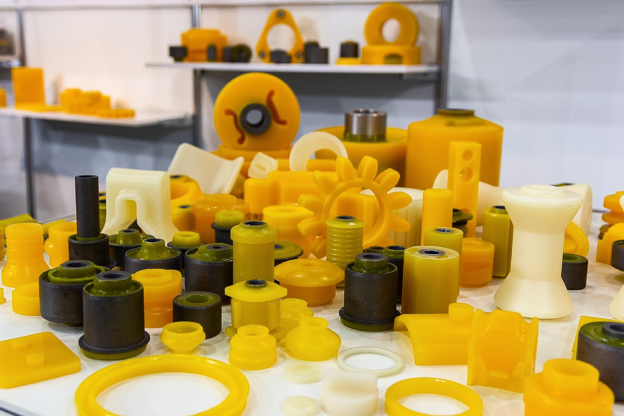A durometer measures how hard or soft a material is, especially rubber and plastic. It gives a hardness value that helps in choosing the right material for different uses. In this article, you’ll learn what is a durometer, how it works, and why it’s important in various industries.
👉Also Read: How Shore Hardness Scales Measure and Determine Polyurethane Properties
Introduction to Durometers
A durometer is a vital tool in material science, measuring the hardness of materials like rubber and plastic. Interestingly, ‘durometer’ refers to both the hardness and the device that measures it. Shore hardness scales, created by Albert Ferdinand Shore, play a key role in quantifying material hardness, serving as a crucial metric for material selection across various industries.
Grasping durometer scales helps determine material suitability for specific applications. For example, Shore hardness directly affects the flexibility and load-bearing capacity of rubber and plastic components.
These scales, ranging from 0 to 100, measure hardness from very soft to very hard materials, aiding engineers and designers in selecting the appropriate durometer.
How Durometers Work
The mechanics of a durometer are both fascinating and straightforward. At its core, a durometer measures a material’s resistance to indentation, which in turn indicates its hardness. The device typically features a spring-loaded pin that penetrates the surface of the material, assessing the resistance it encounters.
Measuring hardness with a durometer involves a few precise steps to ensure accuracy. First, it’s important to identify the correct Shore hardness scale for your material. Once you have the right scale, place the material on a hard, flat surface that is at least ¼ inch thick. This provides a stable base for accurate measurement.
Next, press the durometer firmly onto the sample with the indenter in contact with the material. The gauge will display a reading that reflects the material’s hardness. For better accuracy, take multiple readings from different areas and calculate the average. This method compensates for inconsistencies or variations in the material’s surface.
Durometer values range from 0 to 100, with higher values indicating harder materials. Consistent and precise measurement techniques are crucial for comparing materials and ensuring they meet specific application requirements. This standardized comparison method is invaluable in industries from manufacturing to quality assurance.
Types of Shore Hardness Scales
The Shore hardness scales are indispensable tools for measuring the hardness of various materials. These scales, which range from 00 to 100, provide a comprehensive snapshot of material hardness, making them invaluable in industries that rely on precise material properties.
There are different types of Shore hardness scales, including Shore A, Shore D, and Shore OO, each designed for specific hardness ranges and applications.
Shore A Scale
The Shore A scale measures the hardness of flexible rubbers and plastics, ranging from 0 to 100. Lower values indicate softer materials, while higher values represent harder ones. Polyurethane showcases this variation, from soft athletic shoe soles to hard bowling balls, typically within the 55 Shore A to 75 Shore D range.
Urethane materials perform optimally within this range, making them suitable for diverse applications. Whether you’re dealing with rubber seals, gaskets, or flexible tubing, understanding the Shore A scale is crucial for selecting materials that offer the right balance of flexibility and durability.
Shore D Scale
The Shore D scale measures harder materials, crucial for industries where material hardness is vital. This scale also ranges from 0 to 100, with higher values indicating harder materials. Common applications include hard plastics, rubber, and composites, which require precise hardness measurements to ensure performance and durability.
Industries such as automotive and aerospace frequently use the Shore D scale to measure materials like polyurethane wheels and thick rubber gaskets in metal forming, which often feature tire tread designs. The ability to withstand high load-bearing capacities and resistance to wear makes these materials ideal for demanding applications.
Shore OO Scale
The Shore OO scale is tailored for measuring very soft materials, often used in applications requiring high levels of flexibility and cushioning. This scale is perfect for items like gel shoe inserts and similar products, with values as low as 25 indicating extremely soft materials.
Knowledge of the Shore OO scale aids in selecting materials that offer comfort and adaptability without compromising performance.
Common Durometer Values and Applications
Knowing common durometer values and their applications helps in selecting the right material. Durometer hardness is vital in industries requiring precise material properties for effective design and application.
Different applications demand specific durometer hardness levels, which can significantly affect the performance and durability of polyurethane durometer products.
Soft Materials
Soft materials typically have durometer values ranging from Shore A 30 to Shore A 40. These materials are often used in applications requiring flexibility and shock absorption, such as tire treads and pencil erasers. For instance, K-400A Yellow with a durometer of 40A is commonly used in rollers and bumpers due to its softness and resilience.
The ability of these materials to absorb impact without deforming makes them ideal for applications where cushioning and flexibility are paramount. Knowing durometer scales for soft materials aids in selecting the right material, ensuring optimal performance and longevity.
Medium Hardness Materials
Medium hardness materials, which include most rubbers and semi-rigid plastics, are crucial in many industrial applications. These materials typically fall within the Shore A 50 to Shore D 70 range and are used in products like shock absorbers, wheels, rubber band, and wear pads. The material composition and dynamic mechanical analysis (DMA) provide insights into how these materials respond to stress, affecting their durometer readings.
These materials offer a balance of flexibility and durability, making them suitable for applications that require both properties. Polyurethane used in wheels and wear pads must withstand heavy loads and resist wear, ensuring long-term performance and reliability.
Hard Materials
Hard materials are typically measured on the Shore D scale, which is used for very hard materials like certain plastics and rubbers. These materials, with durometer values extending up to 100, are essential for applications requiring high load-bearing capacity and resistance to wear. Common uses include bowling balls, industrial rollers, and conveyor belts, where durability is critical.
Urethane materials with high Shore D values are ideal for applications involving heavy loads and harsh conditions. Their resistance to abrasion and oil makes them suitable for demanding environments, ensuring that they maintain performance even under extreme stress.
Factors Affecting Durometer Readings
Several factors can influence durometer readings, so it’s important to consider these when measuring hardness. The specific formulation of polyurethane can affect the durometer reading, even if the composition changes. Different formulations can yield the same hardness value, highlighting the need to consider other properties like load-bearing capacity and tear strength.
For instance, the K-750D Brown durometer is known for its excellent load-bearing capacity, making it suitable for demanding applications. Similarly, the K-800A Orange 80A durometer offers good tear strength and flexibility, maintaining performance under various conditions. Quality assurance practices, such as inspections before shipment, ensure that the durometers meet the required standards.
Hardness alone is not an adequate measure of performance. Other factors, such as flexibility, environmental resistance, durability, and the material’s hardness, must also be considered to ensure that the selected material meets all the specific requirements of your application.
Choosing the Right Durometer for Your Needs
Choosing the right durometer involves evaluating several physical properties, including flexibility and load-bearing capacity. Uniflex, Inc. offers expert guidance to help you choose the appropriate durometer hardness and other material characteristics for your specific applications. Prototyping and iterative testing are highly beneficial in this process, allowing you to test different durometer levels and refine your material selection and design.
When choosing a durometer, it’s also important to consider future requirements. Anticipating changes in application needs or regulatory standards can help you plan for scalability and product evolution, ensuring that your material selection remains viable in the long term. For products enduring heavy wear and tear, selecting a material with high Shore D hardness and excellent abrasion resistance is crucial.
Uniflex, Inc. provides a range of resources and tools to assist in this process, including durometer charts and expert consultations. By leveraging these resources, you can ensure that your material selection aligns with your project’s specific requirements, leading to optimal performance and durability.
👉Also Read: Unlocking the Benefits of Cast Urethane Products: A Comprehensive Guide for Businesses
Get Your Custom Solution Today – Contact Uniflex, Inc. for a Free Quote!
For over four decades, Uniflex, Inc. has specialized in the custom manufacturing of polyurethane and rubber products, offering tailored solutions for a wide range of industrial applications, including rubber mold services. Based in Highland, Michigan, the company provides precision CNC machining services and a variety of polyurethane products, including custom-molded solutions and urethane bumpers.
To discuss your project or request a free quote, contact Uniflex, Inc. at 248-486-6000.



